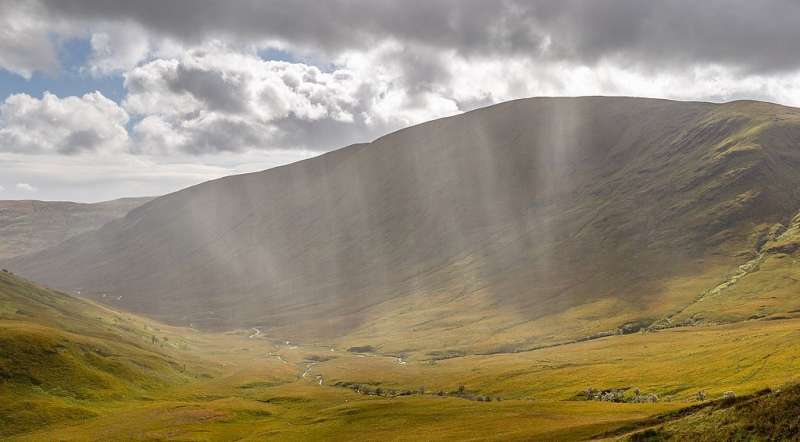Scientists predict average late winter precipitation in western Europe for the next decade

In a new study, scientists at the National Center for Atmospheric Research (NCAR) show that the average March precipitation, over the next ten years in western Europe is predictable using a novel method. The research team also issued a forecast for the coming years.
"Through the year 2027, the forecast indicates that we should expect, on average, wetter winter conditions in the UK and drier conditions in Portugal compared to the most recent ten-year averages," said Stephen Yeager, a climate scientist at NCAR and co-author of the paper.
To make this prediction, scientists used a creative methodology that combines simulations from NCAR's flagship climate model with statistical techniques based on observations. Taken together, the approach—which was validated using "hindcasts" of conditions over the last century—yields a much more skillful prediction than could be made with either the model or observations alone.
"None of the methods alone could capture all the elements needed to make a prediction," said NCAR scientist Isla Simpson, lead author of the research, appearing in the journal Nature Geoscience. "By combining multiple techniques and datasets, we were able to complete the picture."
The predictions could be useful to resource managers and planners, including farmers and water managers, who rely on precipitation forecasts.
Filling the prediction gap
As short-term weather prediction has improved, thanks in part to increases in computing power and observational data, scientists have turned their attention to longer-term predictions, such as determining whether a particular region is likely to be unusually wet or dry over an extended period. These long-term predictions range from seasonal to years or even decades into the future. When working on these timescales, scientists look for atmospheric circulation patterns that are tied to the ocean because the ocean changes at a much slower pace than the atmosphere.
For this new study, scientists turned to the NCAR-based Community Earth System Model (CESM). To test its use in making decadal predictions, they started the model using ocean conditions that approximate historic observations and then looked to see how well the model matched reality as it ran forward a decade at a time. They repeated this for every year between 1954 and 2015, creating a robust test for what can and cannot be predicted on longer timescales.
"The way to test a prediction system is by going backward in time and making predictions of the past, then seeing if they are borne out by the observations that have already been recorded," said Simpson. "If the model is able to use past conditions to accurately predict climate events that have already happened, then there is confidence that the model could skillfully predict climate patterns in the future."
The research showed that CESM was particularly skillful at predicting the sea surface temperatures in the North Atlantic. Scientists know that sea surface temperature is an important factor influencing some weather and climate phenomena, such as tropical cyclones and seasonal climate changes associated with El Niño and La Niña. Yeager's work using CESM had also previously revealed that sea surface temperatures can impact rainfall patterns over the African Sahel years in advance.
Simpson's previous work had suggested that North Atlantic sea surface temperatures also affect the atmospheric circulation patterns over the Atlantic, which then impacts weather in western Europe. Her study in 2018 found that warmer sea surface temperatures in a region called the subpolar gyre of the North Atlantic are associated with a weakening of the westerly jet stream to the west of the UK and a strengthening of the jet stream to the west of Portugal, during the late winter. However, CESM is not yet able to predict those circulation changes.
"There is still a lot we don't understand about that connection between the sea surface, jet stream, and precipitation," said Simpson. "Why is there such a strong connection in western Europe in the late winter, and why can't our models capture it?"
While the model may not be capturing all the ocean and atmospheric interactions that are influencing the late winter rain and snow, in this new study the scientists could still use the model to predict the sea surface temperatures for the upcoming decade. Then they used what is known about this relationship in the real world to make a statistical prediction for rain and snow in western Europe through the year 2027.
"When you combine these two pieces of information—the predicted sea surface temperatures and their relationship to the jet stream derived from observations—it produces a skillful prediction of the precipitation in these regions in March, which is something we haven't been able to do before," said Yeager.
This research represents an important step in bridging the gap between observations and seasonal to decadal forecast modeling, which could be of use to communities looking to prepare for changing weather trends.
"This is exactly the kind of information we are trying to give," said Yeager. "There are people who care if Portugal is going to enter a decade of drought, or high rainfall."
More information: Isla R. Simpson et al. Decadal predictability of late winter precipitation in western Europe through an ocean–jet stream connection, Nature Geoscience (2019). DOI: 10.1038/s41561-019-0391-x
Journal information: Nature Geoscience
Provided by National Science Foundation


















